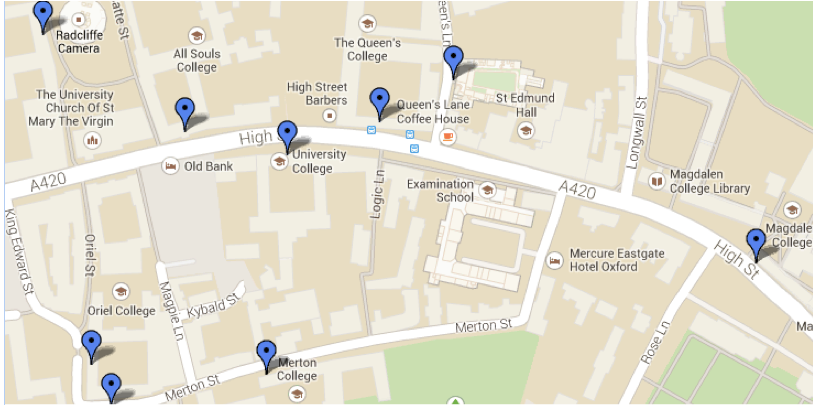So, you’ve decided that the University of Oxford is a great fit for your intellectual curiosity and passion for classics, physics, law, or another of the fifty courses offered at Oxford. Now what? For an introduction to Oxford, read our previous blog here.
Students can only apply to one Oxford College!
Students who wish to attend Oxford University can only apply to only one of the 33 Oxford colleges. In fact, UK students are limited to applying to only five colleges total, of which only one can be from Oxford or Cambridge, collectively known as “Oxbridge.”
How do the Oxford Colleges differ?
While all the Oxford colleges share the fundamental qualities of intellectual rigor, self-directed study, and learning through small tutorials, they each have a very distinct identity. For students who want to attend Oxford, there are a variety of factors that influence their decision of which college to apply to.
- Course of study. Academic subject area is the #1 factor because you apply to a particular course of study. Each of the 33 Oxford colleges offers a subset of the full array of 50 academic fields. For instance, if you are applying for Computer Science, you would need to restrict your options to one of the 13 colleges that offer this field. If you are interested in the “subject combination” of Computer Science and Philosophy, you would have only eight colleges to consider.
- Age of college. Age matters! Some students are more attracted to the older colleges, because they feel they carry more prestige, or they like the feel or look. Professor Sir Drummond Bone, Master of Balliol College, established in 1360, says “Balliol is not only arguably the oldest but arguably the leading intellectual College in Oxford – and therefore in the World. It has stood on a single site longer than any other college in the English-speaking world.”
- Architecture and facilities. The architecture of the colleges varies greatly as a function of the era in which it was build and renovated, and the prevailing styles. Students may also be attracted to particular features of the college such as the library, gardens chapel or dining hall.

Balliol College has a magnificent, grand dining hall, with paintings of many of the Masters and people influential in the history of the college.
- Location within Oxford. The campus is spread throughout the town of Oxford. There is a centralized core of colleges, including the oldest. These colleges are also closer to the center of town, with access to restaurants and shops. Some students prefer these, and others prefer some of the outlying colleges that have more open space. Students may value whether the college is close to the River Thames, or meadows or the University Science Center.

Close-up of High Street, one of the central streets for Oxford University, and the few adjacent colleges.
- Extracurricular activities. Many colleges have a long history of depth in a particular extracurricular activity. For instance, New College is known for its choir, which performs world-wide; Magdalen College is known for theater and orchestra; and Mansfield for journalism.
- Size of student population. The colleges vary from Wycliffe Hall, with 84 undergrads and 22 graduate students, to St. Catherine’s with 487 undergrads and 307 graduate students. Some colleges have no graduate students at all.

New College, 1 of the largest student populations, with 441 undergraduates and 300 graduate students
- Size of the physical campus. The colleges range from a small, intimate physical space, with perhaps one courtyard, such as St. Edmund “Teddy” Hall, to a larger physical imprint with a secondary courtyard and expansive gardens, such as Corpus Christi College.
- Accommodations. Some colleges have all singles, like New College, whereas others have a mix of room types, as at Oriel College. Also, colleges vary in terms of how many years housing is guaranteed, e.g. Mansfield College guarantees housing for only one year, whereas Lincoln College guarantees for all three years.
- Degree of formality. The colleges vary in terms of how formal or informal they are. At more formal colleges, faculty dress in formal gown-attire, students may need to dress up more often; and students are required to address faculty by their titles of Dr. or Professor.
- Alums of the college – both famous and familiar. Balliol College draws students who want to study PPE partly because three recent Prime Ministers of England attended Balliol and studied PPE! In addition, students may be influenced by which colleges their friends, classmates, favorite teachers, family or community members have attended. Jesus College was founded by Elizabeth I, has always had Welsh affiliations, and has the only Celtic Library at Oxford. As result, Welsh students are often steered by their family or school to apply there.
- “Feel” – as with universities in the US and elsewhere, each college has an intangible feel that students may or not resonate with. In the words of several student ambassadors at different colleges during Open Visit Day, “I just felt so happy here when I visited!”
No matter what colleges you decide to apply to, whether they are in the UK, the US or anywhere else in the world, make sure that they offer you the features you need! And if you need guidance, contact Collegiate Gateway. As always, we’re happy to help!










